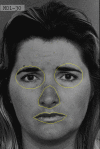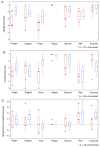Facial emotion recognition in agenesis of the corpus callosum
- PMID: 25705318
- PMCID: PMC4335392
- DOI: 10.1186/1866-1955-6-32
Facial emotion recognition in agenesis of the corpus callosum
Abstract
Background: Impaired social functioning is a common symptom of individuals with developmental disruptions in callosal connectivity. Among these developmental conditions, agenesis of the corpus callosum provides the most extreme and clearly identifiable example of callosal disconnection. To date, deficits in nonliteral language comprehension, humor, theory of mind, and social reasoning have been documented in agenesis of the corpus callosum. Here, we examined a basic social ability as yet not investigated in this population: recognition of facial emotion and its association with social gaze.
Methods: Nine individuals with callosal agenesis and nine matched controls completed four tasks involving emotional faces: emotion recognition from upright and inverted faces, gender recognition, and passive viewing. Eye-tracking data were collected concurrently on all four tasks and analyzed according to designated facial regions of interest.
Results: Individuals with callosal agenesis exhibited impairments in recognizing emotions from upright faces, in particular lower accuracy for fear and anger, and these impairments were directly associated with diminished attention to the eye region. The callosal agenesis group exhibited greater consistency in emotion recognition across conditions (upright vs. inverted), with poorest performance for fear identification in both conditions. The callosal agenesis group also had atypical facial scanning (lower fractional dwell time in the eye region) during gender naming and passive viewing of faces, but they did not differ from controls on gender naming performance. The pattern of results did not differ when taking into account full-scale intelligence quotient or presence of autism spectrum symptoms.
Conclusions: Agenesis of the corpus callosum results in a pattern of atypical facial scanning characterized by diminished attention to the eyes. This pattern suggests that reduced callosal connectivity may contribute to the development and maintenance of emotion processing deficits involving reduced attention to others' eyes.
Keywords: Corpus callosum; Corpus callosum agenesis; Facial emotion.
Figures




References
-
- Aboitiz F. Brain connections: interhemispheric fiber systems and anatomical brain asymmetries in humans. Biol Res. 1992;25:51–61. - PubMed
-
- Booth R, Wallace G, Happé F. Connectivity and the corpus callosum in autism spectrum conditions: insights from comparison of autism and callosal agenesis. Prog Brain Res. 2011;189:303–317. - PubMed
LinkOut - more resources
Full Text Sources
Other Literature Sources
Molecular Biology Databases

